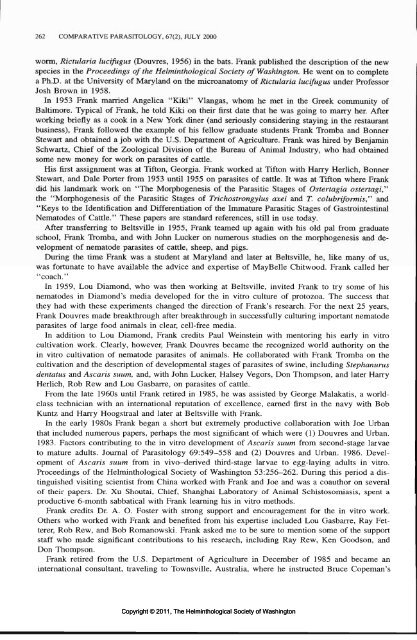Comparative Parasitology 67(2) 2000 - Peru State College
Comparative Parasitology 67(2) 2000 - Peru State College
Comparative Parasitology 67(2) 2000 - Peru State College
Create successful ePaper yourself
Turn your PDF publications into a flip-book with our unique Google optimized e-Paper software.
262 COMPARATIVE PARASITOLOGY, <strong>67</strong>(2), JULY <strong>2000</strong><br />
worm, Rictularia lucifugus (Douvres, 1956) in the bats. Frank published the description of the new<br />
species in the Proceedings of the Helminthological Society of Washington. He went on to complete<br />
a Ph.D. at the University of Maryland on the microanatomy of Rictularia lucifugus under Professor<br />
Josh Brown in 1958.<br />
In 1953 Frank married Angelica "Kiki" Vlangas, whom he met in the Greek community of<br />
Baltimore. Typical of Frank, he told Kiki on their first date that he was going to marry her. After<br />
working briefly as a cook in a New York diner (and seriously considering staying in the restaurant<br />
business), Frank followed the example of his fellow graduate students Frank Tromba and Bonner<br />
Stewart and obtained a job with the U.S. Department of Agriculture. Frank was hired by Benjamin<br />
Schwartz, Chief of the Zoological Division of the Bureau of Animal Industry, who had obtained<br />
some new money for work on parasites of cattle.<br />
His first assignment was at Tifton, Georgia. Frank worked at Tifton with Harry Herlich, Bonner<br />
Stewart, and Dale Porter from 1953 until 1955 on parasites of cattle. It was at Tifton where Frank<br />
did his landmark work on "The Morphogenesis of the Parasitic Stages of Ostertagia ostertagi"<br />
the "Morphogenesis of the Parasitic Stages of Trichostrongylus axei and T. colubriformis," and<br />
"Keys to the Identification and Differentiation of the Immature Parasitic Stages of Gastrointestinal<br />
Nematodes of Cattle." These papers are standard references, still in use today.<br />
After transferring to Beltsville in 1955, Frank teamed up again with his old pal from graduate<br />
school, Frank Tromba, and with John Lucker on numerous studies on the morphogenesis and development<br />
of nematode parasites of cattle, sheep, and pigs.<br />
During the time Frank was a student at Maryland and later at Beltsville, he, like many of us,<br />
was fortunate to have available the advice and expertise of MayBelle Chitwood. Frank called her<br />
"coach."<br />
In 1959, Lou Diamond, who was then working at Beltsville, invited Frank to try some of his<br />
nematodes in Diamond's media developed for the in vitro culture of protozoa. The success that<br />
they had with these experiments changed the direction of Frank's research. For the next 25 years,<br />
Frank Douvres made breakthrough after breakthrough in successfully culturing important nematode<br />
parasites of large food animals in clear, cell-free media.<br />
In addition to Lou Diamond, Frank credits Paul Weinstein with mentoring his early in vitro<br />
cultivation work. Clearly, however, Frank Douvres became the recognized world authority on the<br />
in vitro cultivation of nematode parasites of animals. He collaborated with Frank Tromba on the<br />
cultivation and the description of developmental stages of parasites of swine, including Stephanunis<br />
dentatus and Ascaris suum, and, with John Lucker, Halsey Vegors, Don Thompson, and later Harry<br />
Herlich, Rob Rew and Lou Gasbarre, on parasites of cattle.<br />
From the late 1960s until Frank retired in 1985, he was assisted by George Malakatis, a worldclass<br />
technician with an international reputation of excellence, earned first in the navy with Bob<br />
Kuntz and Harry Hoogstraal and later at Beltsville with Frank.<br />
In the early 1980s Frank began a short but extremely productive collaboration with Joe Urban<br />
that included numerous papers, perhaps the most significant of which were (1) Douvres and Urban.<br />
1983. Factors contributing to the in vitro development of Ascaris suum from second-stage larvae<br />
to mature adults. Journal of <strong>Parasitology</strong> 69:549-558 and (2) Douvres and Urban. 1986. Development<br />
of Ascaris suum from in vivo—derived third-stage larvae to egg-laying adults in vitro.<br />
Proceedings of the Helminthological Society of Washington 53:256-262. During this period a distinguished<br />
visiting scientist from China worked with Frank and Joe and was a coauthor on several<br />
of their papers. Dr. Xu Shoutai, Chief, Shanghai Laboratory of Animal Schistosomiasis, spent a<br />
productive 6-month sabbatical with Frank learning his in vitro methods.<br />
Frank credits Dr. A. O. Foster with strong support and encouragement for the in vitro work.<br />
Others who worked with Frank and benefited from his expertise included Lou Gasbarre, Ray Fetterer,<br />
Rob Rew, and Bob Romanowski. Frank asked me to be sure to mention some of the support<br />
staff who made significant contributions to his research, including Ray Rew, Ken Goodson, and<br />
Don Thompson.<br />
Frank retired from the U.S. Department of Agriculture in December of 1985 and became an<br />
international consultant, traveling to Townsville, Australia, where he instructed Bruce Copeman's<br />
Copyright © 2011, The Helminthological Society of Washington

















